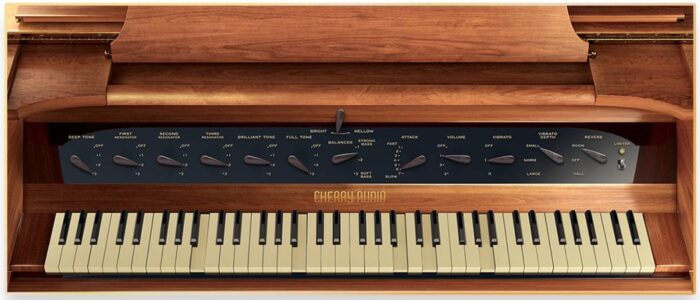Novachord v1.0.2.21-R2R
Team R2R | 12 Jul 2023 | 31.9 MB
Notorious
Manufactured by the Hammond company from 1939 to 1942 and debuting at the World’s Fair, the Novachord contained 163 vacuum tubes and over 1,000 custom capacitors. Its divide-down oscillator architecture combined full 72-key polyphony with an early version of analog subtractive synthesis. The Novachord’s architecture predicted the ADSR envelope, utilized a resonant band-pass filter, and included a vibrato unit. These now-familiar methods resemble designs adopted decades later in Moog and ARP polyphonic synthesizers.
Despite its historical importance, the Novachord did not enjoy commercial success. Although it resembled a standard organ at a glance, the front panel controls were not well-suited to the performance techniques of organists or pianists of the period. In addition, the numerous vacuum tubes were unstable, making the 500-pound instrument challenging to maintain. Production stopped in 1942 because of poor sales and parts shortages during the Second World War, with Hammond only manufacturing around 1,000 Novachords.
Nevertheless, the instrument was used for decades on many notable era recordings, such as We’ll Meet Again by Vera Lynn and Brother Bones’s Sweet Georgia Brown. It was also prominently featured in film soundtracks including the intermission for “Gone With the Wind” and in the scores of “Rebecca,” “The Maltese Falcon,” and “The Ten Commandments.” But it is best remembered for its otherworldly sound as heard in horror and sci-fi genre productions such as “Cat People,” “The Beast From 20,000 Fathoms,” “20 Million Miles to Earth,” and “The Gorgon.” On television, the Novachord remained a favorite of composers including Jerry Goldsmith and Harry Lubin in their work for The Twilight Zone and The Outer Limits, respectively. Today, fewer than 200 Novachords exist, and it is said that only five remain in operation.
Novachord Features:
32 polyphonic voices, synthesized not sampled.
Three Resonators: a resonant bandpass filter network operating consecutively in low (400 Hz), mid (800 Hz), high (2000 Hz) frequency ranges.
Deep Tone setting for the tone generator signal, with a one-pole (6dB per-octave slope) lowpass filter with a fixed frequency of 160 Hz.
Brilliant Tone setting for the tone generator signal, with a one-pole (6dB per-octave slope) highpass filter with a fixed frequency of 2000 Hz.
Full Tone setting controls the amplitude of the dry (no filters applied) tone generator signal.
Tones routed in parallel to all of the filters, processed and then summed together to create a composite tone.
Attack knob with seven Attack/Decay/Sustain envelope options, from Slow to Fast, with sustain-pedal controlled release (approximately3.5 seconds).
Adjustable depth vibrato with two options: Vibrato I as used in the earliest Novachord models, and Vibrato II as used in later Novachords.
Integrated reverb effect with Room and Hall algorithms plus speaker emulation to replicate the Novachord’s built-in amp and speakers in an acoustic space.
56 presets covering Basses, Keys, Pads, and Strings, by Director of Sound Design James Terris.
Standard for Both Instruments:
Complete MIDI control and DAW automation for all controls, with easy-to-use MIDI learn and mapping (Preset and Global).
Cherry Audio’s popular Focus zoom-in feature, as well as standard UI zoom and resize via drag.
Complete documentation available directly online from the instrument or in downloadable PDF format.
User-adjustable oversampling control.
Please REPORT in Comment Broken Links


